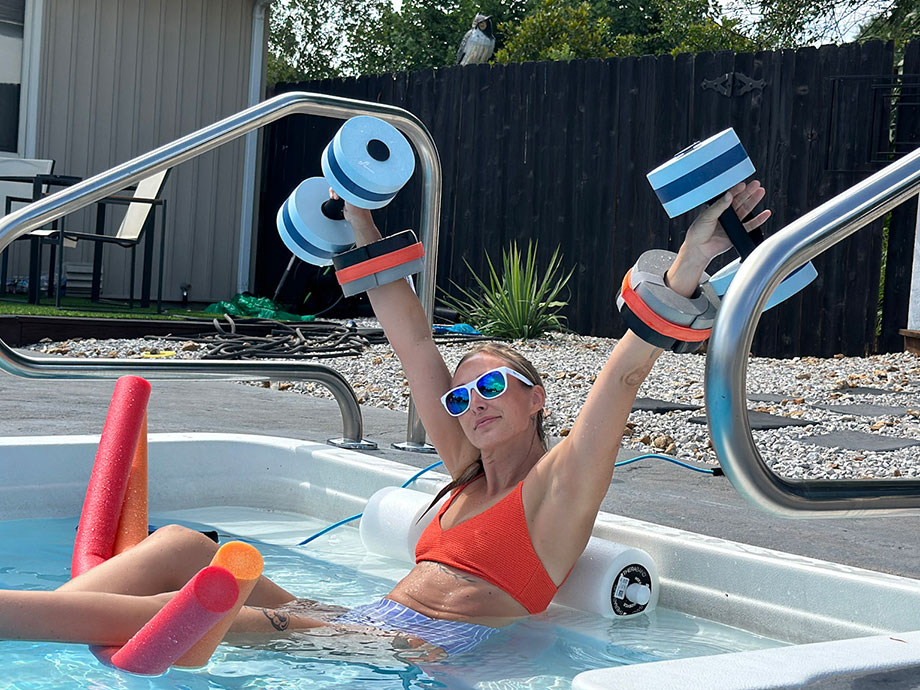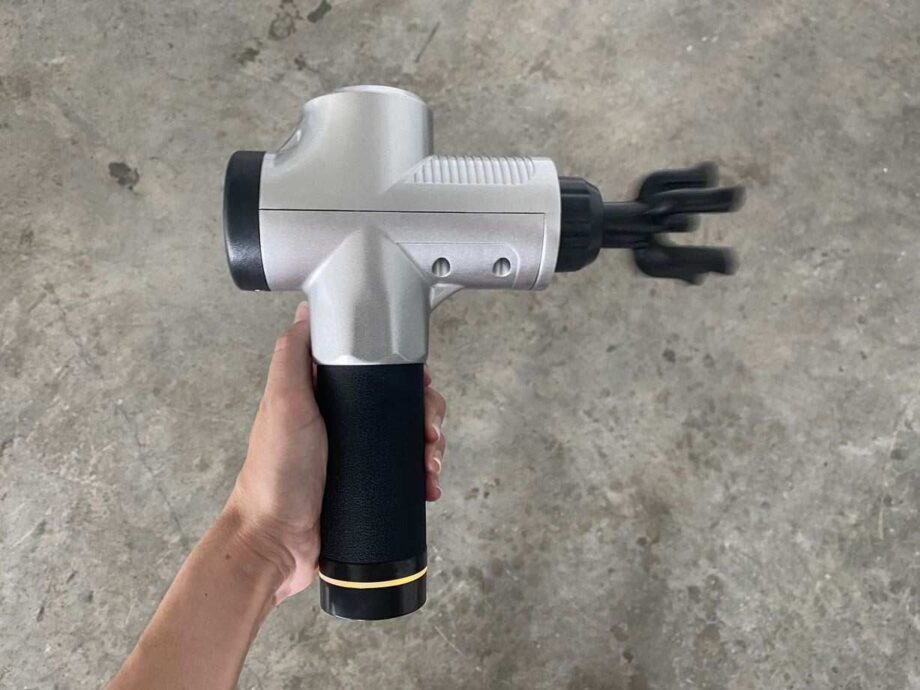Make no mistake about it: Losing weight is as much of a mental challenge as it is a physical one. As someone who once tipped the scales at 285 pounds, I can sympathize with those who struggle to keep their body weight in check and keep negative self-talk from sabotaging their success.
However, one of the biggest lessons I learned during my 75 Hard Challenge journey was that finding creative ways to switch up your workout routine can help you continue to burn fat and build self-confidence. While I’m still a huge advocate of hitting the gym for a traditional strength training session or high-intensity full-body workout, I’ve also come to appreciate the simplicity and serenity of using a swimming pool to support your calorie-burning efforts.
RELATED: Pool Exercises
Although you may be quick to dismiss water workouts due to their low-impact nature, you’ll be surprised at just how challenging and effective they can be when you have the right tools, mindset, and plan of attack. As a certified personal trainer (CPT) who’s tried everything from classic resistance training to pilates to aerobics classes to get in shape, I’ll help you navigate what can be complicated hydrotherapy waters by breaking down my 12 favorite pool exercises for weight loss.
In addition, I’ll give you a sample workout and go over the equipment you need to maximize the health benefits of this valuable form of low-impact exercise. So, grab a towel, apply some sunscreen, and get ready to reshape your body (and mind) by relying on the buoyancy of good ol’ H2O.
12 Best Pool Exercises for Weight Loss
- Water walk or jog
- Treading water
- Treading boat
- Pool plank
- Jumping jacks
- Flutter or scissor kick
- Lunge
- Bicycle kick
- High knee jog
- Dolphin kick
- Tuck jump
- Squat
Water Walk or Jog
Muscles worked: Quadriceps, hamstrings, glutes, calves, core
Benefits: Whether it’s on land or in the water, walking is a simple, accessible form of cardiovascular exercise that can be a great way for beginners or those recovering from an injury to get started. Picking up the pace to a jog will increase your heart rate, challenging your stamina and overall fitness level.
How to do it:
- Stand in chest-deep water with your body completely upright.
- Begin walking through the water, letting your arms swing naturally by your sides.
- Increase the pace to a jog, driving your arms back and forth in a running motion.
- Continue for the desired duration or distance.
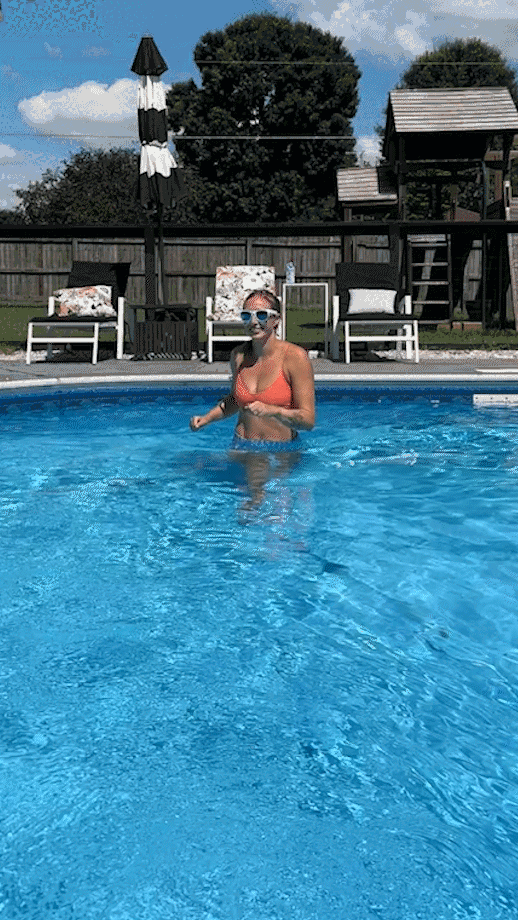
Treading Water
Muscles worked: Rectus abdominis, obliques, transverse abdominis, quadriceps, glutes, hamstrings, hip flexors, deltoids, latissimus dorsi, trapezius, triceps
Benefits: An aquatic exercise that gets your entire body involved, treading water tests everything from your cardiovascular and muscular endurance to your core strength to your mental resolve. Stabilizing your body requires excellent abdominal engagement. Meanwhile, you must coordinate your upper body and lower body movements to keep your head above water.
How to do it:
- Stand in the deep end of the pool (or as deep as you can comfortably go) with your feet about shoulder-width apart.
- Extend your arms out to your sides and begin making small, circular motions.
- Engage your core muscles and start kicking back and forth so your feet remain above the bottom of the pool.
- Maintain a steady rhythm for the desired amount of time.
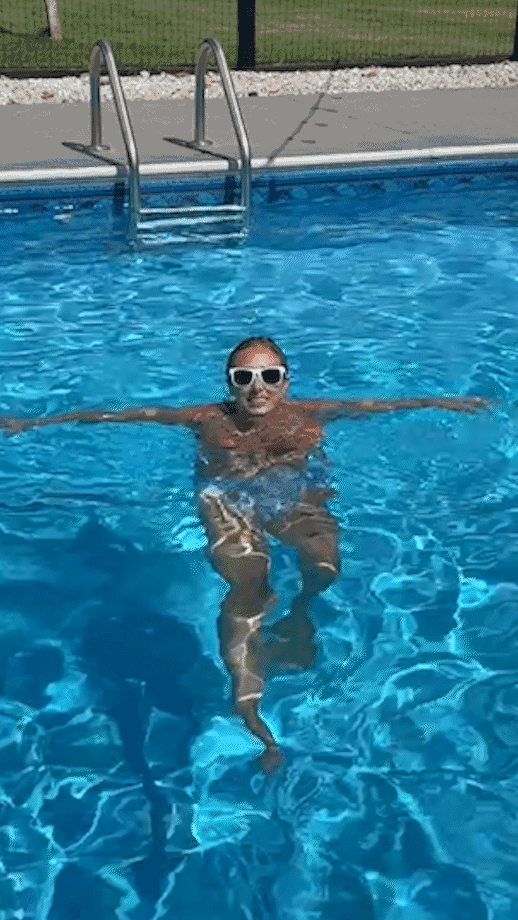
Treading Boat
Muscles worked: Deltoids, latissimus dorsi, rhomboids, rectus abdominis, hip flexors, erector spinae
Benefits: Similar to treading water, treading boat takes more of a horizontal position than a vertical one. This aerobic and core-strengthening exercise requires excellent coordination, as you must move your arms and legs synergistically to stay afloat.
How to do it:
- Stand in chest-deep water.
- Lean back slightly so your body is almost parallel to the surface of the water.
- Extend your legs out in front of you and your arms out to your sides.
- Simultaneously bring your knees toward your chest while bringing your arms together in front of you.
- Extend your legs and arms back to the starting position, repeating this sequence for the desired amount of time.
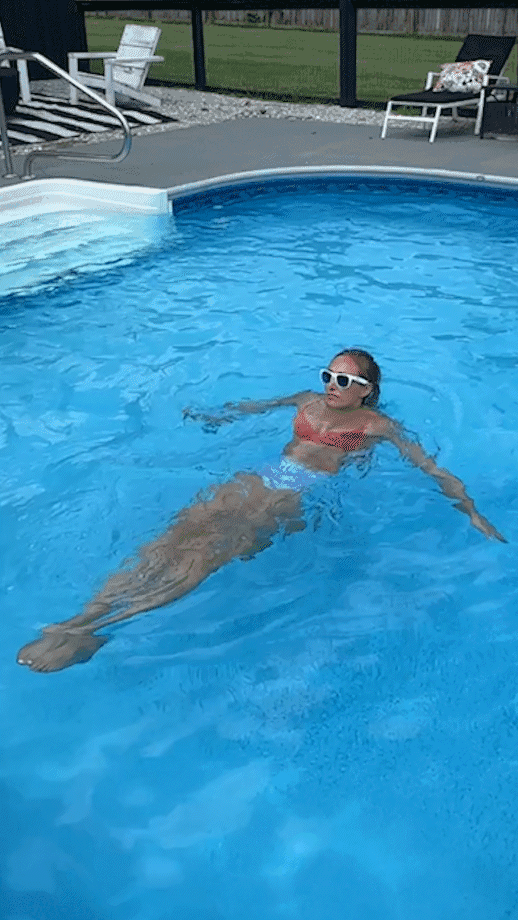
Pool Plank
Muscles worked: Rectus abdominis, obliques, transverse abdominis, erector spinae, deltoids, rhomboids, trapezius, glutes
Benefits: This water-based plank relies on a pool noodle for support. Although this tool provides an assist, your rectus abdominis, erector spinae, and other core and lower back muscles still bear most of the responsibility for keeping your body as perfectly straight as possible. Whether on land or in the water, planking is a great way to support good posture.
How to do it:
- Stand in chest-level water.
- Hold onto a pool noodle placed horizontally in front of you.
- Extend your legs behind you so your body forms a straight line.
- Engage your abdominal muscles, maintain a neutral spine, and hold the plank position for the desired amount of time.
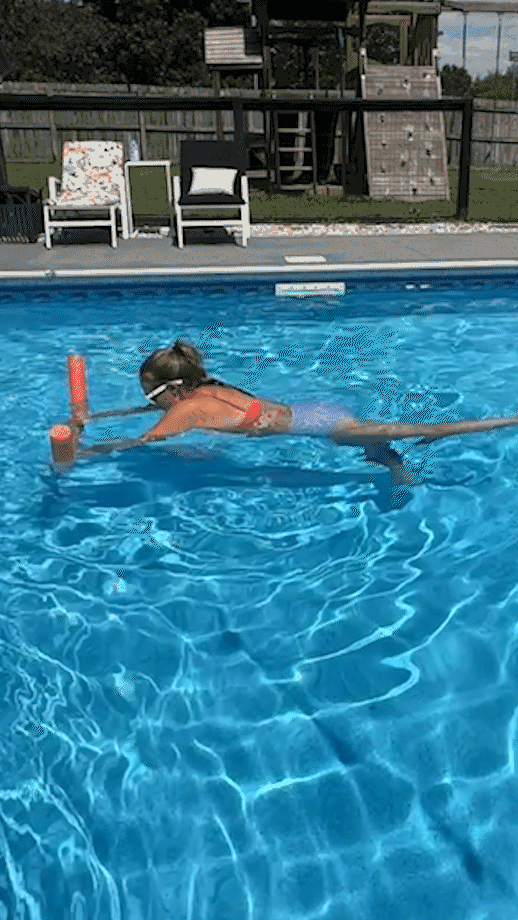
Jumping Jacks
Muscles worked: Deltoids, latissimus dorsi, quadriceps, glutes, calves, trapezius, core
Benefits: A full-body cardio exercise that’s fairly easy on land will feel much different under water. The added resistance will give your arms, legs, heart, and lungs a serious challenge. You can also take jumping jacks to another level using ankle weights for even more resistance.
How to do it:
- Stand in chest-deep water with your feet together and hands at your sides.
- Jump your legs out while simultaneously bringing your arms together overhead.
- Return to the starting position and repeat for the desired amount of time or reps.
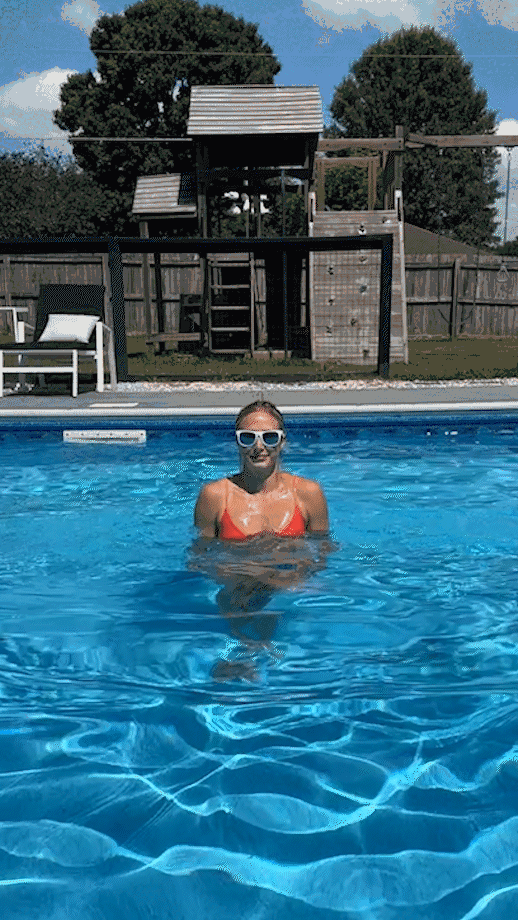
Flutter or Scissor Kick
Muscles worked: Rectus abdominis, obliques, transverse abdominis, erector spinae quadriceps, glutes, hamstrings, hip flexors
Benefits: Hit your lower abs, hip flexors, glutes, and quads with a simple but effective exercise that also offers cardio benefits. Flutter kicks—also referred to as scissor kicks—will help you construct a rock-solid core and strong legs. If you don’t have access to a kickboard, simply hold on to the edge of the pool for support.
How to do it:
- Hold onto a kickboard or the edge of the pool with your arms fully extended.
- Extend your legs behind you, keeping them straight and as close together as possible.
- Engage your core, then start kicking your legs up and down quickly in a controlled motion.
- Maintain a neutral spine and steady pace for the desired amount of time.
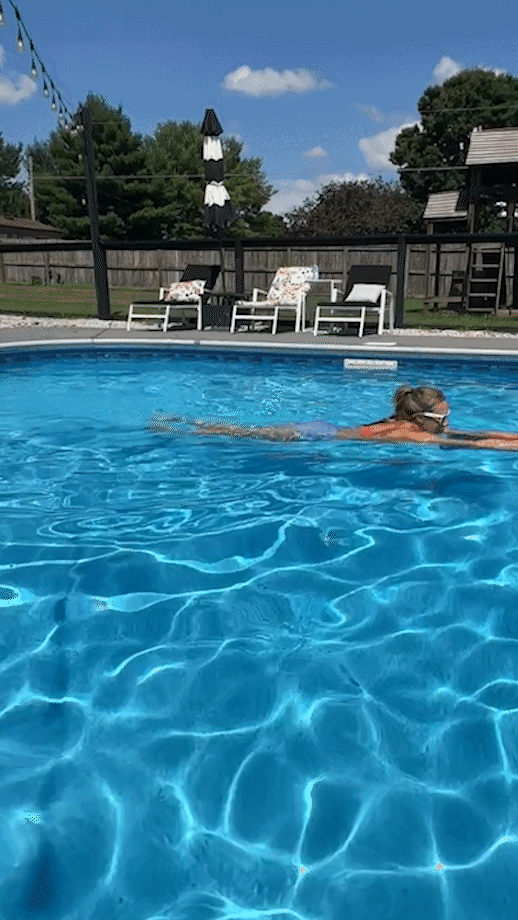
Lunge
Muscles worked: Quadriceps, hamstrings, glutes, core
Benefits: A fundamental movement pattern everyone should master, the lunge is an excellent unilateral exercise that challenges your balance, coordination, and stability. This pool-based, plyometric version helps burn calories and enhance your conditioning by requiring you to push off explosively, alternating sides for as long as you can handle.
How to do it:
- Stand in water that’s between waist and chest level with your feet about hip-width apart.
- Step your left foot into a lunge position, bending both knees to lower your body so your legs are at 90-degree angles.
- Push off the bottom of the pool explosively with both feet, jumping up in the water while bringing your right leg forward and left leg back.
- Land softly in a lunge position with your right leg forward and left leg back.
- Alternate legs with each jump, making sure to maintain an upright torso throughout.
- Repeat for the desired number of reps or time.
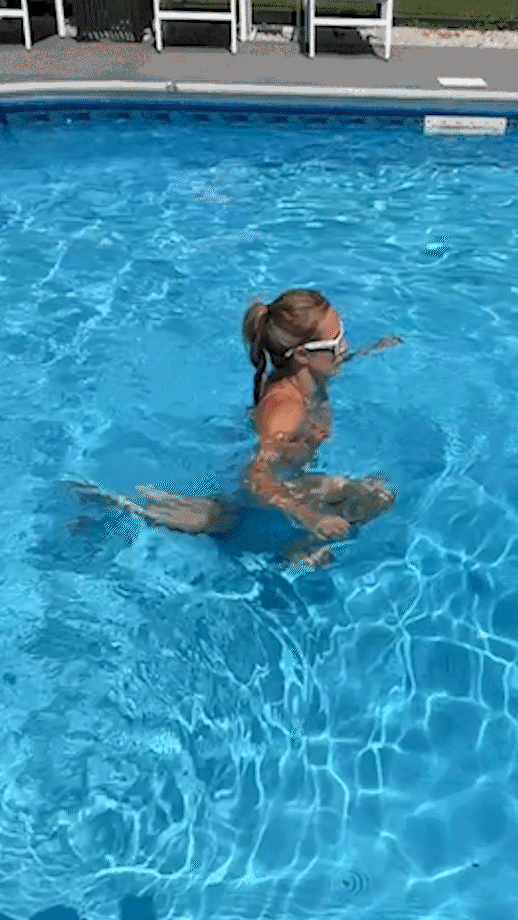
Bicycle Kick
Muscles worked: Hamstrings, glutes, hip flexors, rectus abdominis, erector spinae
Why do it: While you can’t pedal your way to a six-pack, you can develop a strong, stable core by emulating a bicycle motion in the water. If you’ve neglected targeted abdominal work for a while, don’t be surprised when your core starts burning quickly.
How to do it:
- Lean back and hold onto the pool rail or edge of the pool for support.
- Engage your core and lift your legs so they’re almost parallel with the water.
- Pedal your legs back and forth as if you’re riding a bicycle.
- Keep tension on your abs and continue kicking in a steady motion for the desired amount of time.
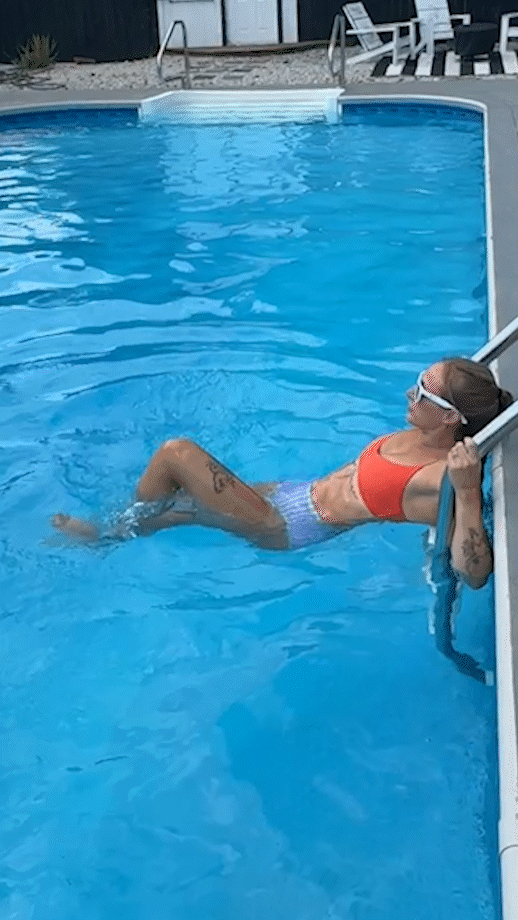
High Knee Jog
Muscles worked: Rectus abdominis, obliques, transverse abdominis, erector spinae, hip flexors, quadriceps, glutes, hamstrings, calves, deltoids
Benefits: High knees are one of my favorite warm-up exercises, as they quickly get your blood pumping and increase your heart rate. Hastening the pace to a jog will take this aerobic exercise to another level, especially once you encounter increased resistance in the deeper end of the pool.
How to do it:
- Stand in chest-deep water with your feet hip-width apart.
- Explosively drive your left knee toward your chest as high as possible while keeping your right foot planted on the bottom of the pool.
- Lower your left knee, then immediately lift your right knee toward your chest.
- Alternate sides, making sure to pump your arms in rhythm with your legs to increase the intensity.
- Maintain a steady pace for the desired amount of time or distance.
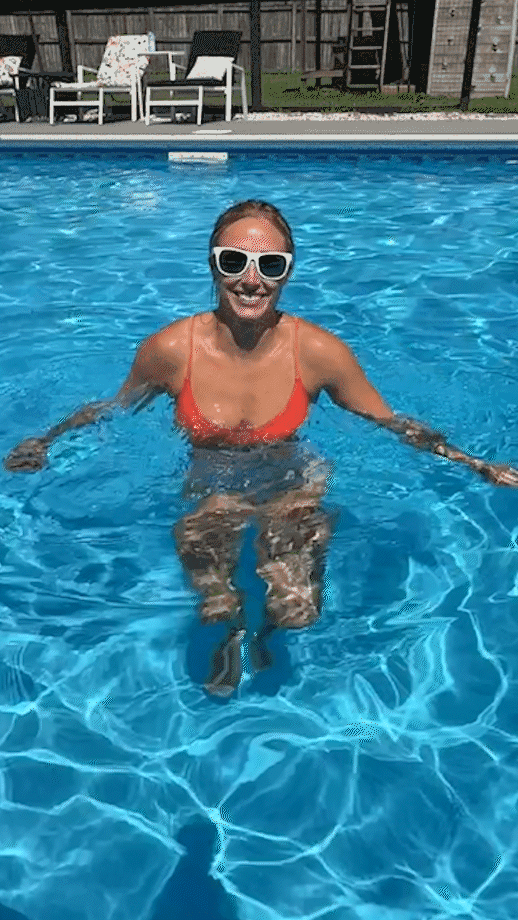
Dolphin Kick
Muscles worked: Erector spinae, rectus abdominis, obliques, transverse abdominis, glutes, hamstrings, quads, deltoids, rhomboids, trapezius
Benefits: Channeling your inner dolphin is an effective way to engage your abdominal muscles, glutes, hamstrings, and even your upper body. One of my top pool exercises for abs, dolphin kicks can help you build a solid core that’ll look even better as you melt away body fat.
How to do it:
- Stand in the shallow end of the pool, holding onto a kickboard with your arms fully extended and your face down toward the water.
- Keep your legs together and kick them up and down in a wave-like motion that mimics a dolphin’s movement pattern.
- Swim to the opposite side of the pool, then turn around and use the same technique to return to the shallow end.
- Repeat for the desired amount of time or repetitions.
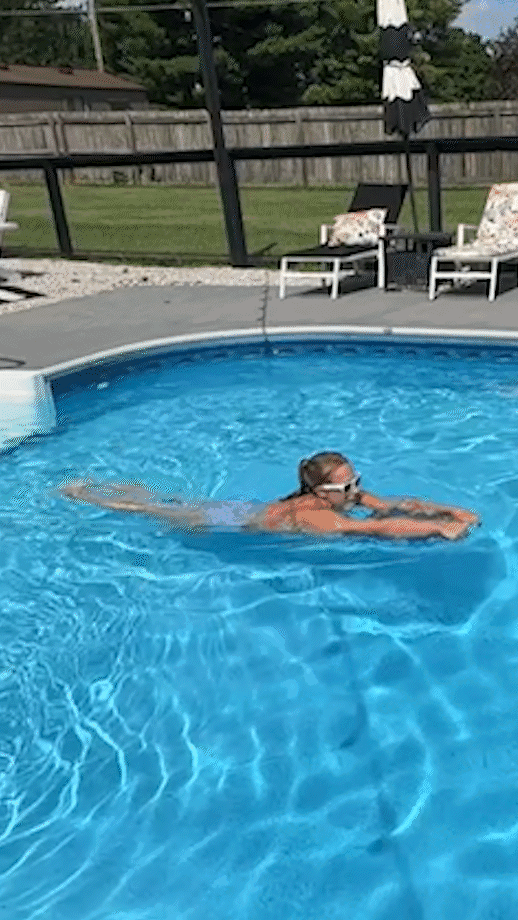
Tuck Jump
Muscles worked: Quadriceps, glutes, hamstrings, calves, core
Why do it: Doing tuck jumps on solid ground can be quite taxing on your joints. However, the water-based version is much more forgiving. Although there’s less impact on your knees, hips, and ankles, you can still get a great cardio workout by repeatedly exploding off the bottom of the pool and driving your knees toward your chest.
How to do it:
- Stand in chest-deep water with your feet about hip-width apart.
- Engage your core and drive your knees toward your chest by jumping explosively off the bottom of the pool.
- Swing your arms back as your knees reach your chest.
- Lower your legs to return to the starting position, immediately following with the next jump.
- Repeat for the desired amount of time or reps.
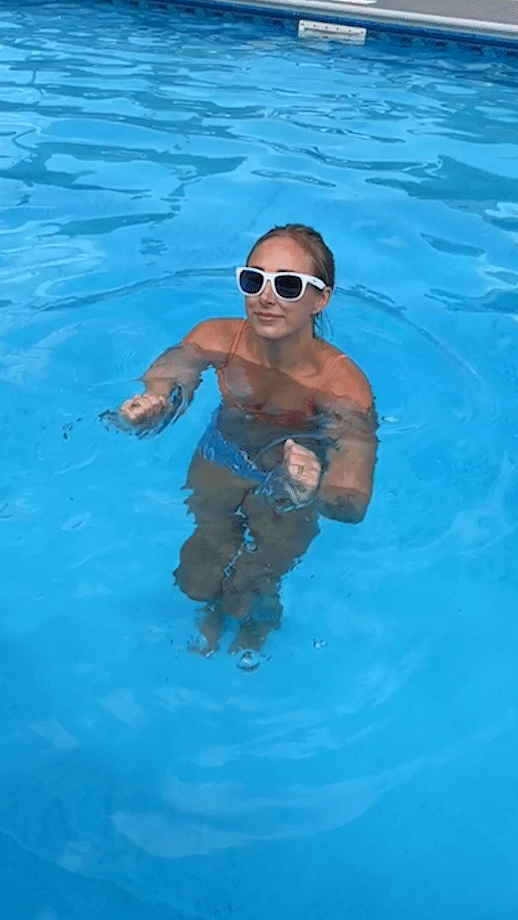
Squat
Muscles worked: Quadriceps, glutes, hamstrings, calves, core
Benefits: Bodyweight squats may not provide the same strength-building stimulus as a set of heavy back squats or a series of barbell front squats, but they can still be a valuable part of your aqua-based workout routine. A compound exercise that recruits all of your lower-body and core muscles, you can make pool squats more difficult by extending your arms overhead, holding onto foam dumbbells, or adding a jumping element to make it more of a plyometric exercise.
How to do it:
- Stand in waist-deep water with your feet shoulder-width apart and toes pointed slightly out.
- Extend your arms straight out in front of you.
- Descend into a squat position by bending your knees and driving your hips back.
- Lower yourself down until your legs form a 90-degree angle.
- Hold the bottom of the squat for 1-2 seconds, then push through your heels to return to the starting position.
- Repeat for the desired number of reps.
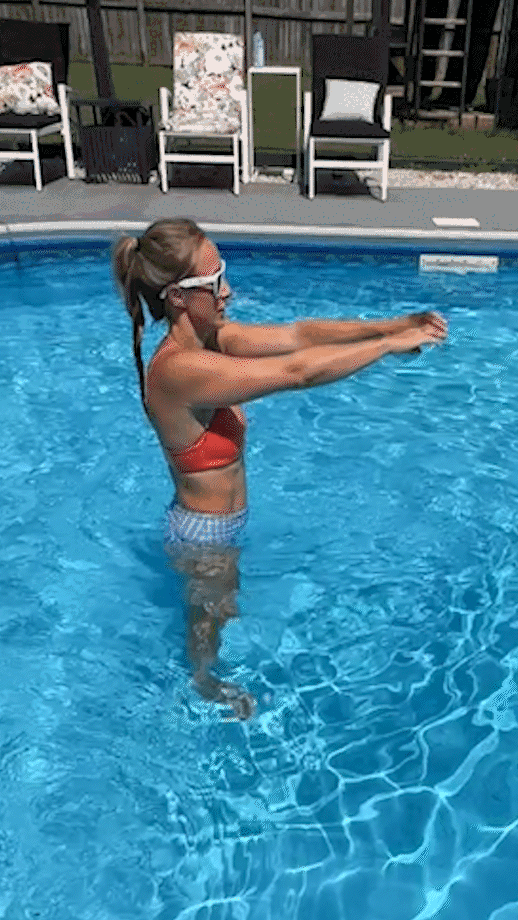
Sample Pool Workout for Weight Loss
As a CPT and dedicated fitness enthusiast, I’m all about efficiency. During my 80-pound weight-loss journey, I utilized high-intensity interval training (HIIT) extensively to help shed fat, build muscle, and improve my conditioning.
RELATED: Best Pool Exercise For Abs
This pool workout for weight loss takes a similar approach, challenging you to perform each of the 12 exercises in a circuit-style fashion. Your work intervals may not be long (just 30 seconds), but you should give maximum effort. If you’re a beginner, cut the reps and time in half and progress your way toward that 30-second/20-rep benchmark.
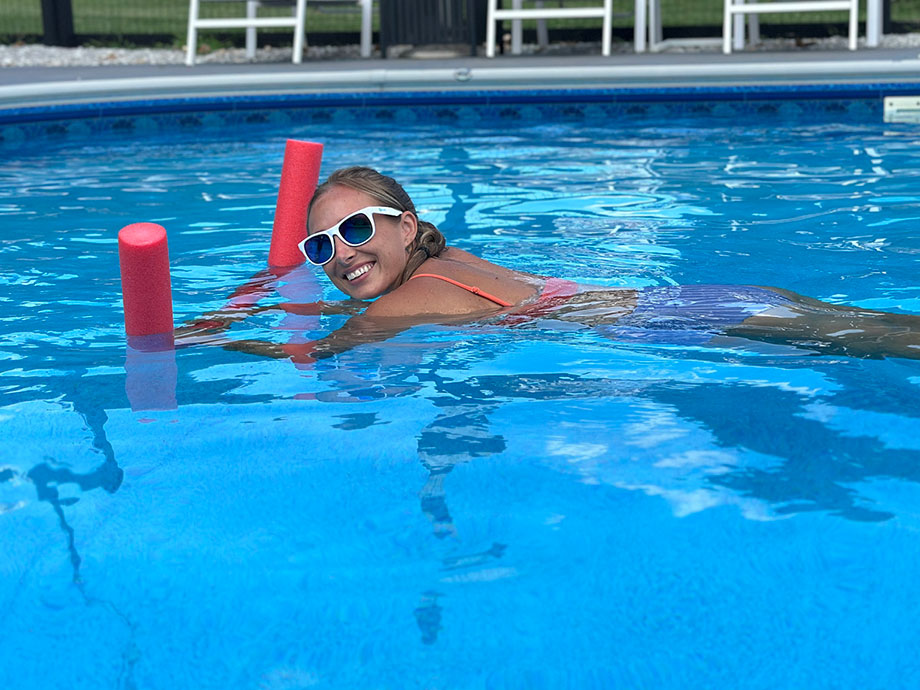
Keep your rest time minimal between exercises—no more than 30 seconds. Once you’ve completed one round of the circuit, rest for about 2 minutes and repeat two or three times, depending on your fitness level.
| Exercise | Reps/Time |
| Water Walk or Jog | 30 sec. |
| Squat | 20 reps |
| High Knee Jog | 30 sec. |
| Lunge | 10 reps per leg |
| Dolphin Kick | 30 sec. |
| Tuck Jump | 20 reps |
| Bicycle Kick | 30 sec. |
| Jumping Jacks | 20 reps |
| Flutter Kick | 30 sec. |
| Treading Boat | 30 sec. |
| Pool Plank | 30 sec. |
| Treading Water | 30 sec. |
RELATED: Treadmill Walking Workout for Weight Loss
Benefits of Pool Exercises for Weight Loss
Water workouts allow you to enjoy many of the same benefits as land-based ones, including burning calories and helping you develop muscular strength and endurance. However, aquatic exercises also offer distinct advantages.
Here’s why you should spend a little more time in a swimming pool to support your weight-loss efforts.
Can Be Effective at Changing Body Composition
Burning fat and building muscle comes down to key factors such as your total caloric intake, macronutrient balance, and amount (and type) of physical activity. While I’d never advise replacing strength training with just pool exercises, aquatic training can be a useful way to help change how your body looks.
According to a 2023 systematic review1, water aerobics is beneficial for improving body composition. However, research shows you must train for at least 120 minutes per week to experience this benefit. That’s quite a bit of time in the pool, so you will have to make your workout plan accordingly.
RELATED: Body Recomposition
Low Impact on Your Joints
Perhaps the biggest benefit of aquatic exercises is the impact (or lack thereof) on your joints. Unlike training on land, working out in the pool takes little toll on your hips, knees, and ankles. According to a 2017 study2, compared to the same activities on land, joint forces were reduced by 36% to 55% in water, making pool exercises for weight loss particularly valuable for those with joint pain or related issues.
RELATED: Best Low-Impact Exercises
Little to No Equipment Needed
Can equipment enhance your training experience? Of course.
Is it necessary for pool exercises for weight loss? Not at all.
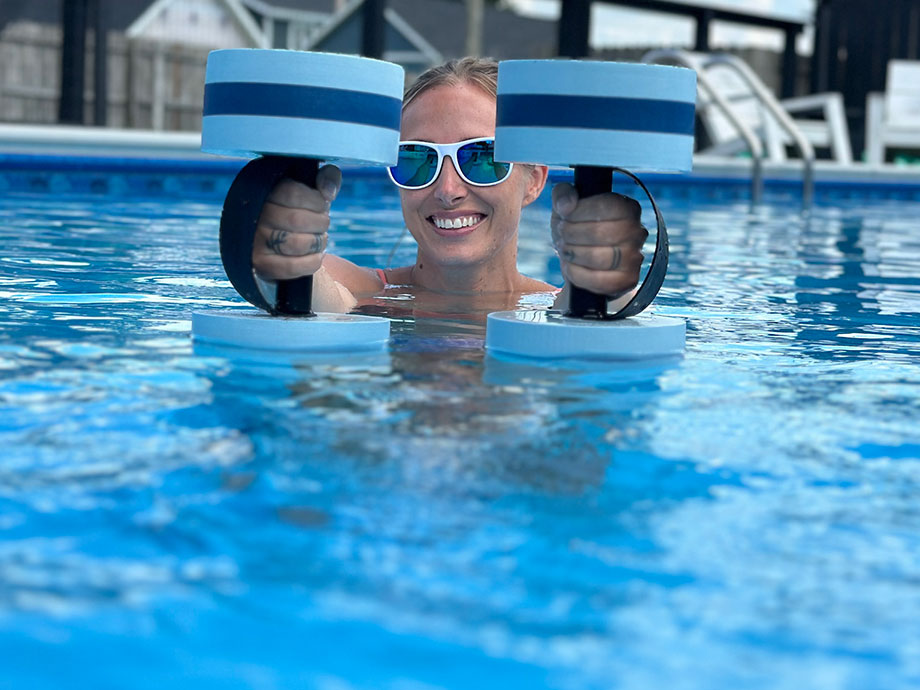
As long as you have a swimming pool filled with clean water, you’re well on your way to a great workout. Exercises like treading water and tuck jumps don’t require anything other than your body weight and all-out effort. Plus, you can easily purchase a kickboard, water shoes, foam water weights, and a pool noodle for far less than the best squat rack or set of the best adjustable dumbbells.
Adaptable to Your Fitness Level
Pool exercises can be as difficult or easy as you want them to be. Beginners can just use their body weight and still get an effective workout. On the other hand, more advanced athletes can strap on ankle weights to make treading water more challenging or use foam water weights for resistance exercises like lateral raises and biceps curls.
RELATED: Best Bodyweight Exercises
Take Advantage of Water Resistance
Who says you must use a barbell and weight plates to build strength? Working out in the water can provide unlimited resistance, especially when you’re in the deep end of the pool. According to a 2014 study3 on the properties of water and their applications for training, this medium enables “the stimulation of metabolic and neuromuscular systems” thanks to factors such as density, hydrostatic pressure, and buoyancy.
RELATED: Benefits of Water Aerobics
Pool Exercises: Equipment Needed
Although you can get by without any equipment, you can enhance your aquatic training by having a few tools handy. Here’s a brief overview of some common accessories that can provide support (or an extra challenge) when you work out in the water.
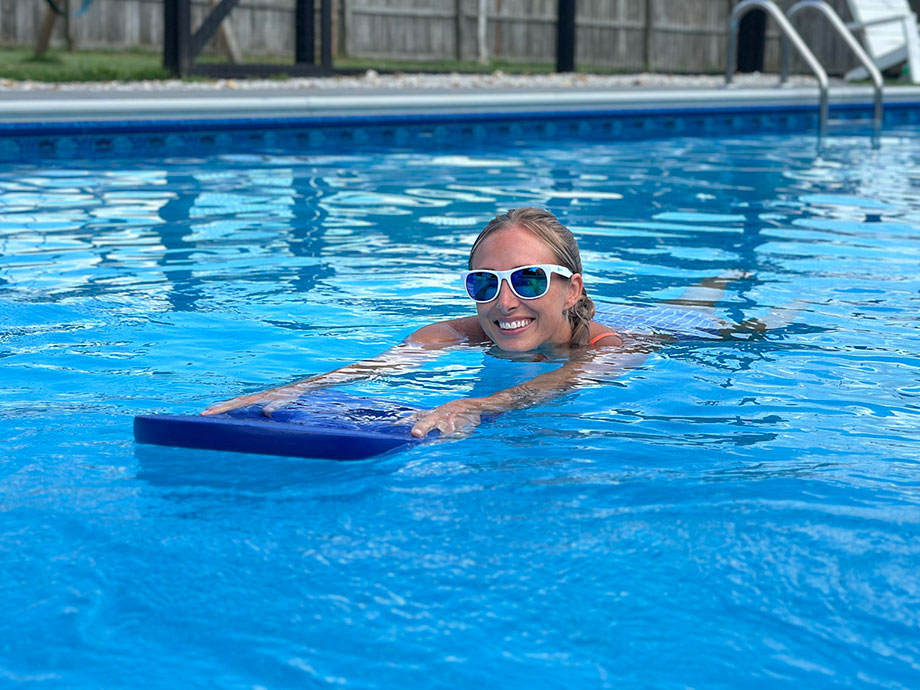
- Pool noodle: Used for balance and support for exercises like pool planks.
- Kickboard: A flat, buoyant board that you can hold onto for movements like dolphin kicks or use for resistance exercises in the water.
- Water shoes: These specialized shoes protect your feet from getting scraped by the bottom of the pool. They’re also useful for water-based activities like kayaking and boating.
- Foam water weights: Lighter and cheaper than traditional dumbbells, foam water weights can help you build strength from the pool.
- Foam aquatic cuffs: Just like you can use ankle weights on land, you can attach aquatic cuffs around your ankles to add resistance, making exercises like the high knee jog or even treading water much more difficult.
RELATED: Best Ankle Weights
Pool Exercises for Weight Loss: Final Thoughts
A swimming pool can be a peaceful sanctuary where you kick back and relax. It also can be a place where you put in some serious work to help trim inches off your waistline and get in the best shape of your life.
As a dedicated #GymRat, I’m still in favor of pumping iron and crushing some HIIT treadmill workouts. Yet I’m also willing to take my workouts to the water (on occasion) to give my joints a much-needed break and challenge myself to perform at a high level in a different environment.
So, whether you’re at the beginning of your journey or you’ve been struggling to break a weight loss plateau, I encourage you to dive headfirst into the world of pool exercises and commit to torching fat with a little help from our favorite compound: H2O.
Pool Exercises for Weight Loss: FAQs
Can you lose weight with pool exercises?
Yes, pool exercises can help you lose weight by burning calories and helping you build lean muscle. However, you still need to be in a calorie deficit to lose weight.
How long should I walk in a pool to lose weight?
Based on a 2023 systematic review1, you must perform at least 120 minutes of water aerobics per week to see body composition changes. As a CPT, I recommend including a mix of pool exercises for weight loss and traditional strength training to see the best results.
Can I lose belly fat by swimming?
While swimming is a great cardiovascular exercise that offers many health benefits, no activity can specifically help you lose belly fat. This concept—known as spot-targeting—is not supported by science.
What burns the most calories in the pool?
Swimming generally burns the most calories, as it’s a full-body exercise that engages multiple muscle groups and provides a significant cardiovascular challenge.
References
- Zhu, H., Jin, J., & Zhao, G. (2023). The effects of water-based exercise on body composition: A systematic review and meta-analysis. Complementary Therapies in Clinical Practice, 52, 101766. https://doi.org/10.1016/j.ctcp.2023.101766
- Kutzner, I., Richter, A., Gordt, K., Dymke, J., Damm, P., Duda, G. N., Günzl, R., & Bergmann, G. (2017). Does aquatic exercise reduce hip and knee joint loading? In vivo load measurements with instrumented implants. PLoS ONE, 12(3), e0171972. https://doi.org/10.1371/journal.pone.0171972
- Torres-Ronda, L., & Del Alcázar, X. S. I. (2014). The Properties of Water and their Applications for Training. Journal of Human Kinetics, 44(1), 237–248. https://doi.org/10.2478/hukin-2014-0129



